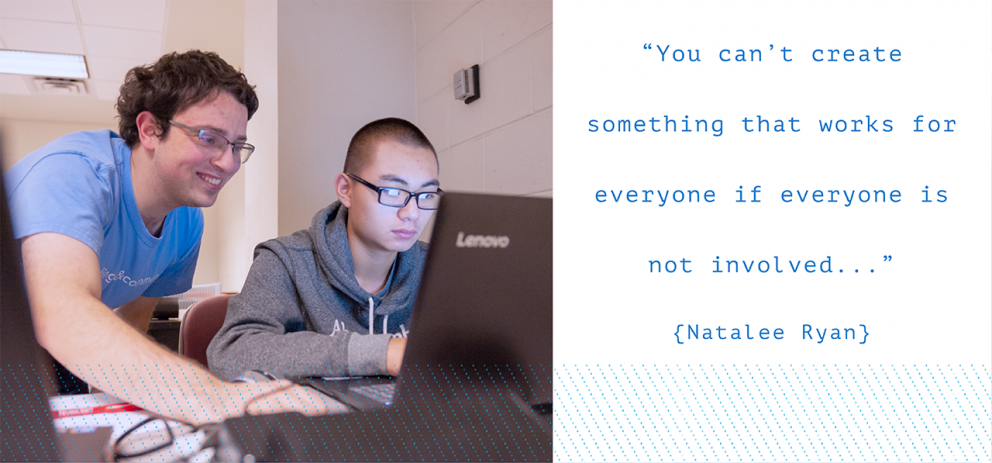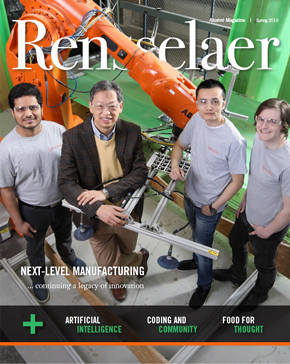
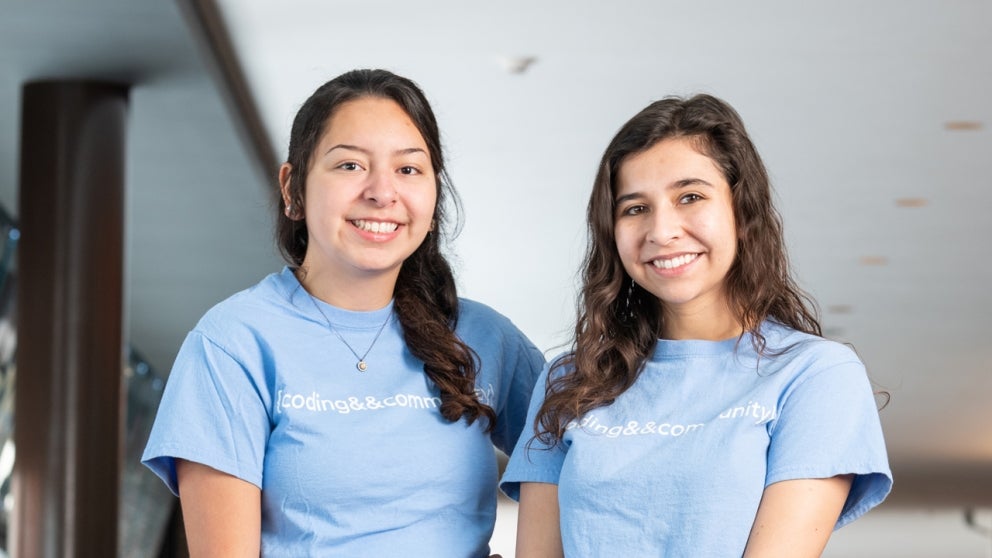
{coding&&community} Bridging the Gap in Computer Science Education
A boundary-breaking student-run club is preparing future generations of computer scientists.
By Regina Stracqualursi
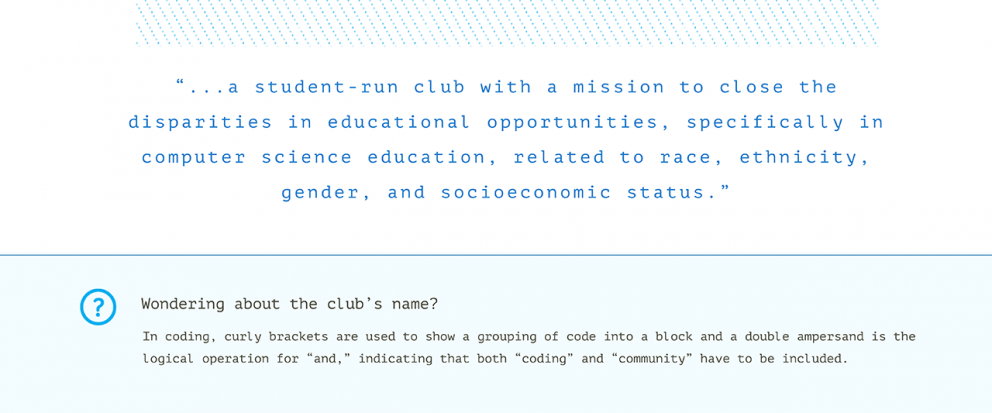
There is nothing quite like the hustle and bustle going on in Troy, New York, on a Saturday morning. Thousands of people scope out the best deals at the Troy Waterfront Farmers’ Market, families enjoy brunch at their favorite local eateries, friends drink coffee as they browse a slew of small boutiques, and hidden behind the walls of the J Building on Rensselaer Polytechnic Institute’s campus, a group of college students donate their time to teach local middle school and high school students how to code. The brains behind the operation, Milena Gonzalez, is a junior computer science major at Rensselaer on a mission to close the gap in computer science education.
Gonzalez recalls the moment that changed her life forever and sparked her desire to create more diversity in the computer science industry, a moment that came when she was only a sophomore in high school. That defining moment was the day her robotics teacher pulled her aside and encouraged her to apply for a Girls Who Code program. Girls Who Code, an organization dedicated to growing the number of women in computer science, provides a variety of opportunities for young women to learn computer science including clubs, coding courses, and summer programs. Up until this moment, Gonzalez had never thought that coding, something that seemed like a fun hobby, could transform into an empowering and rewarding career. Her initial reaction is indicative of the significant gender gap that exists in the computer science industry, and Girls Who Code leaders work every day to reverse the ongoing decline in female computer scientists.
After she was accepted to a Girls Who Code summer immersion program, Gonzalez spent seven weeks learning about computer science, working on coding projects, listening to guest speakers, and visiting some of the most thriving tech companies in Silicon Valley, such as Facebook and Google. After those seven weeks, Gonzalez knew not only that she wanted to pursue a STEM degree as a computer science major but also that she wanted to continue to advocate for more diversity and representation in the field.
“I really fell in love with the program and its mission. I liked that they were advocating for so many people,” says Gonzalez. “Their emphasis was on women, but I think there needs to be a stronger emphasis on all underrepresented groups.” Gonzalez went on to found a Girls Who Code club at her high school in San Ramon, California.
One year later and nearly 3,000 miles away in the small city of Ogdensburg, New York, Natalee Ryan was anxiously preparing for her first year away at college. After participating in PREFACE, a two-week summer program in which underrepresented students learn about technological professions, she knew that Rensselaer Polytechnic Institute was a place where she could be passionate about technology. Ryan’s defining moment came when she received an email from a friend who’d remembered her interest in computers. The email invited those who enjoy working with technology to apply for Google’s Computer Science Summer Institute, a coding boot camp for underrepresented students about to embark on their collegiate journeys.
After being accepted into the program, Ryan spent three weeks of her summer vacation at the Google Cambridge Campus, where she learned the fundamentals of computer science and what a career in computer science might look like. She fell in love with the discipline and decided to pursue it over her originally declared major, biomedical engineering. “I went home and started learning as much as I could about computer science before coming to RPI,” she says.
Connecting On Coding
Paths crossed for Gonzalez and Ryan the second semester of freshman year when they both enrolled in Arts, Community, and Technology, a course that examines the intersection between art, education, and technology. The students were tasked with a semester-long project that needed to address art and technology, be interdisciplinary, and benefit the Troy community. Gonzalez, who had already been trying to start a club similar to Girls Who Code, saw this as the perfect opportunity to advance her vision. Ryan felt a personal connection to the cause and was eager to join forces with Gonzalez.
“We both had the past experience of having the community passionate about helping us succeed, so we wanted to do the same thing,” Ryan says. The two women spent the remainder of the semester attending meetings with student leaders and administrators, drafting and finalizing their club’s constitution, and recruiting club members. As the semester progressed, their dream finally turned into a reality.
In spring of 2017, coding&&community launched as a student-run club with a mission “to close the disparities in educational opportunities, specifically in computer science education, related to race, ethnicity, gender, and socioeconomic status.” The club strives to accomplish its mission by hosting classes each semester and hackathons, workshops, and other events each academic year, all at no cost to students and their families. In fall of 2017, the club began teaching classes every Saturday to students participating in the New York State Science and Technology Entry Program (STEP), a program funded by the New York State Education Department to prepare disadvantaged and underrepresented students for scientific, technical, and health-related fields.
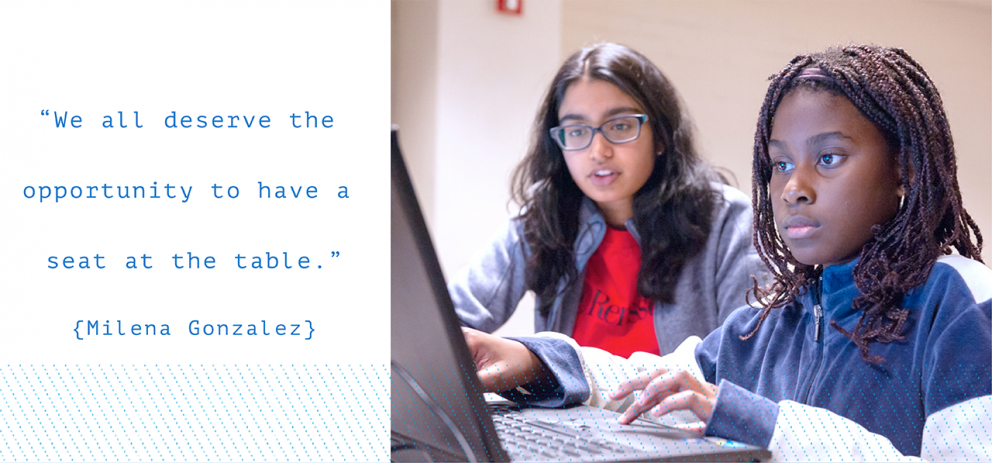
Coding&&community’s addition to this program has opened up the world of computer science to secondary school students across the New York Capital Region. “We strongly believe that you cannot be what you cannot see, so we want to be that presence for our students,” says Gonzalez. “We all deserve the opportunity to have a seat at the table.”
The club gives underrepresented students a brighter future by not only exposing them to computer science and computational thinking, but also providing them with the vital skills needed to succeed in college, their careers, and society. Each Saturday class begins with an hour enrichment session, where coding&&community members lead activities to enhance students’ public speaking, critical thinking, and other essential skills. The remaining two hours focus on a computer science lesson during which students are exposed to a variety of in-demand programming languages such as Python, HTML, CSS, and JavaScript, and introduced to platforms such as Sonic Pi, GitHub, and Arduino. “Our goal is not to make all students computer science majors. We want to show them what they are able to do with technology and what types of opportunities are out there for them,” says Gonzalez.
While a typical classroom has one teacher among many students, coding&&community maintains a ratio of at least one instructor for every two students, with one main instructor leading each class. “The number of instructors we have is actually the biggest advantage we have,” says Ethan Graf, vice president of the club for the 2018-2019 academic year. “We’re able to give one-on-one time to every single student, every single day.”
As soon as the lead instructor finishes introducing an activity, students find coding&&community instructors sitting right beside them. The instructors, ready to support and guide the students as they complete a practice exercise, have one important rule to follow — don’t touch the keyboard. “They’re not there to code for them,” says Grace Roller, the club’s current president. “They’re there to provide support and help them through any hurdles they are facing.” The goal is that by working on these activities with coding&&community instructor support, the students will walk away from the classes confident in their abilities, with a physical portfolio of the work they’ve completed.
When the coding&&community team first set out on their mission, they quickly experienced firsthand the barriers students face that stand in the way of technological career paths. The student leaders, who had mentally prepared for all the challenges they might face in the classroom, were surprised when the biggest hurdle for students wasn’t comprehending the logic associated with computer science but instead, was finding the semicolon on the keyboard. “We learned that it’s not just that students don’t have exposure to computer science, it’s that some don’t even have exposure to computers,” says Graf. “You can’t be expected to learn to program if you don’t have the opportunity to first learn how to type effectively.”

Gaps in Computer Science
As they reflect on their personal experiences in computer science education, Gonzalez and Ryan remember knowing which of their classmates had prior exposure to the discipline and which did not, based on their behavior in the classroom. As they watched once overfilled lecture halls empty as peers dropped the major, it was many of the students who had no pre-collegiate exposure to computer science that were ill-prepared for the intensity of the field and the depth of the material. Gonzalez, who is reminded of the gap in computer science every day as the only woman and minority in many of her classes, knows how discouraging it can be to not see role models with similar backgrounds finding success in the field.
“We need to keep breaking that glass ceiling to make sure that the next generation of computer scientists represents more inclusion and diversity,” she says. “We want our students to have a seat at that table.”
In telling the alarming story of an automatic soap dispenser released to market that only worked for light skin tones, anger fills Gonzalez’s eyes. Aside from computer science having a strong job market and vast career opportunities that many students miss out on due to barriers beyond their control, the lack of women and minorities in the field poses challenges in further developing the technology that impacts everyday life. In order for new technology to be successful, it must be accessible and provide an intuitive, seamless experience for all groups of people who are using it.
“You can’t create something that works for everyone if everyone is not involved,” says Ryan. “You have to have everyone’s perspectives involved from the start.”
Throughout the past two years, coding&&community has grown from five club members to nearly 25. The club serves roughly 15 students every Saturday and up to 80 at one-day events and workshops. What started as one course on Saturday mornings has now grown to two, one for beginners and one for students with prior experience.
However, coding&&community’s work is not yet finished; the student leaders have big visions for what their club can evolve to be and how many students they can serve. Currently, the club is working to host a Girls Who Code after-school program at Capital Region middle schools and high schools, as well as create professional development workshops for teachers interested in bringing the world of computer science into their classrooms.
With class size limited to the number of computers they have access to and a pledge to keep all services free of charge, coding&&community members are constantly recruiting company sponsors, applying for scholarships, and volunteering with other organizations on campus in order to secure funds for additional laptops for the club. They hope that with newer laptops and updated software, they can one day introduce students to advanced topics such as application development, game development, augmented reality, and virtual reality.
As Gonzalez, Ryan, and many of the other club leaders get closer to the end of their journey at Rensselaer, they place a strong focus on knowledge transfer and are giving younger club members the opportunity to work in leadership positions to ensure that the club’s mission lives on long after their graduation.
“I am confident that this club will surpass me and go on to reach many more students than I ever could have imagined,” says Gonzalez.
